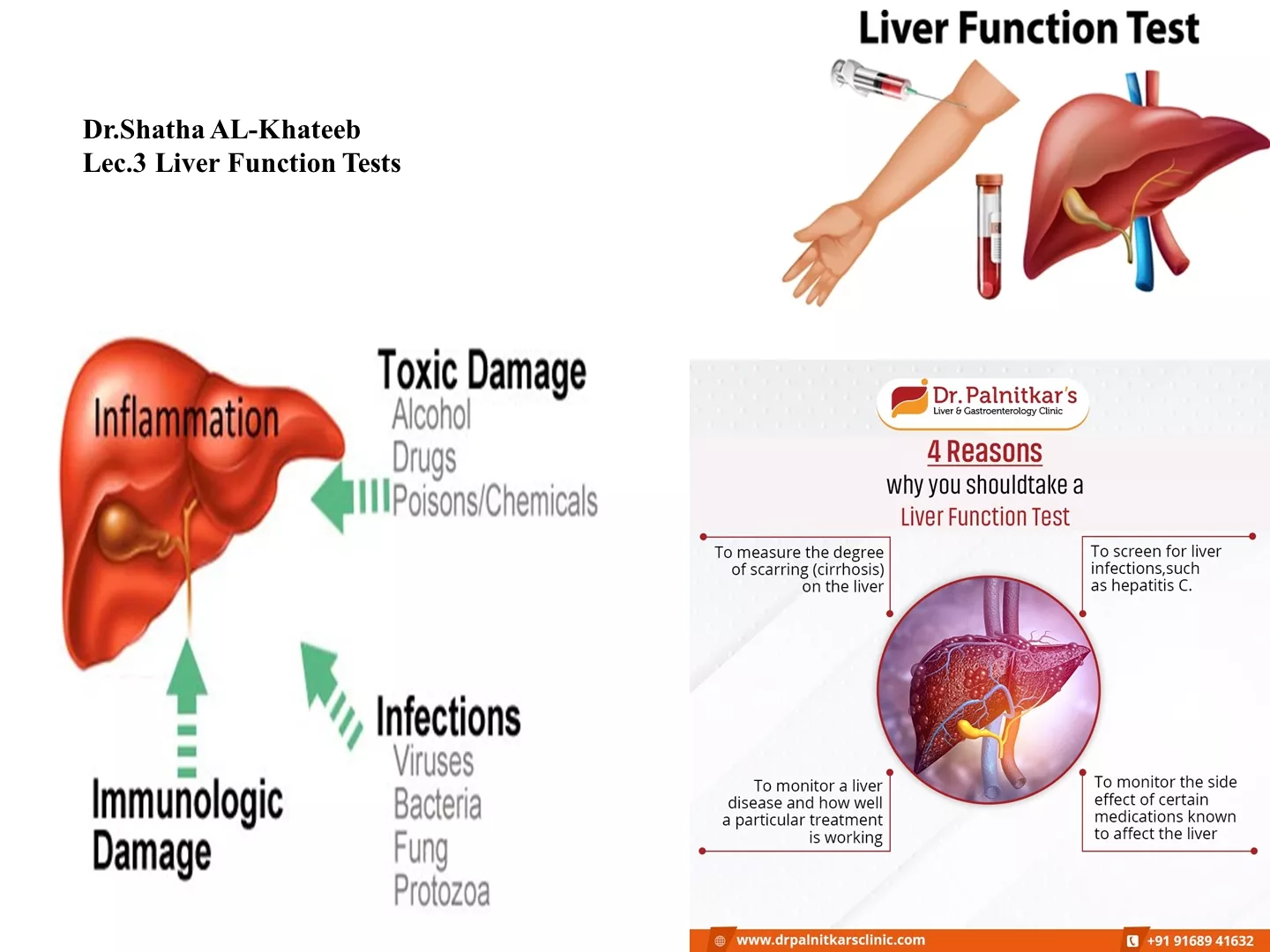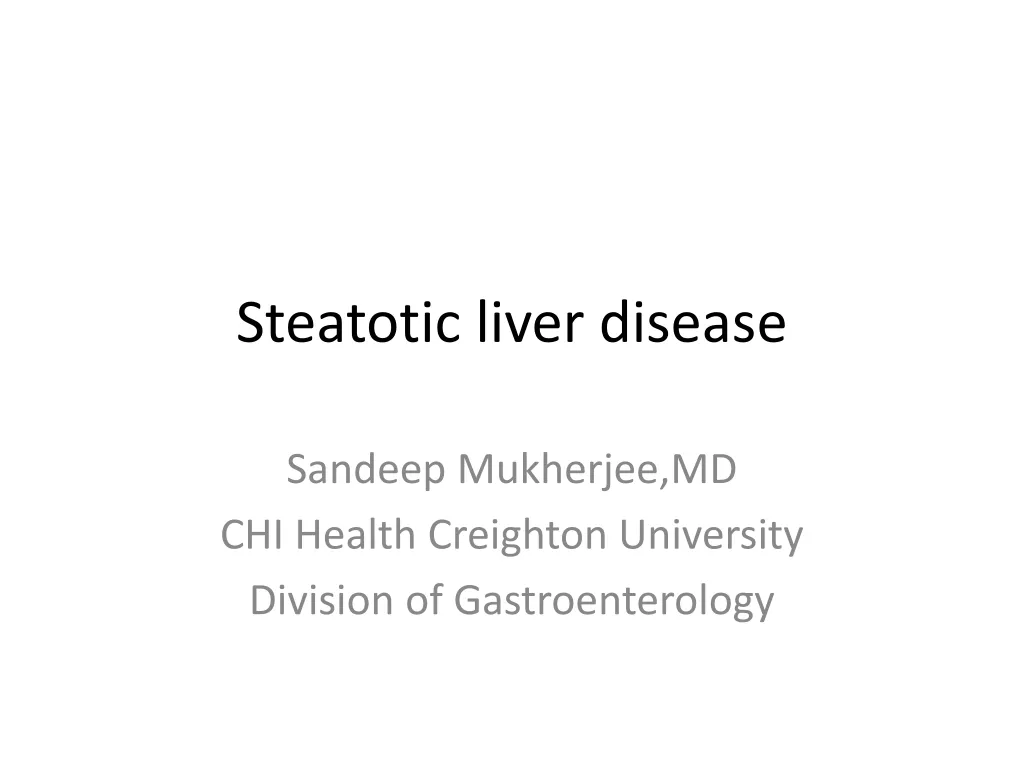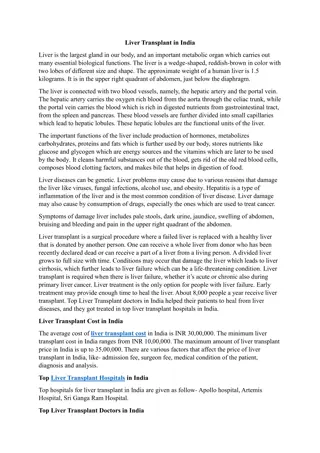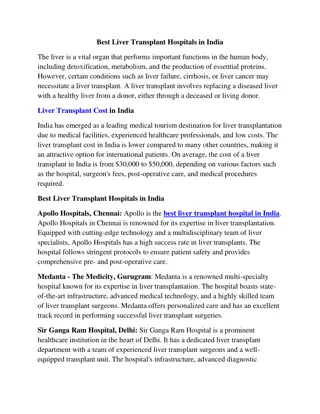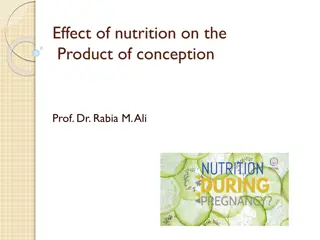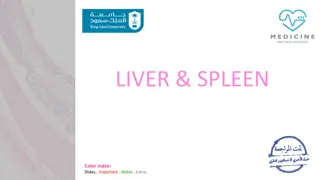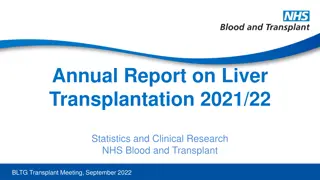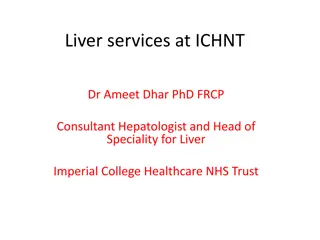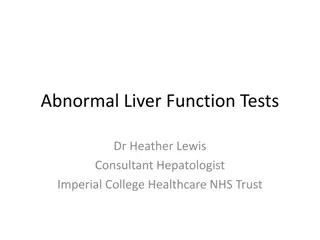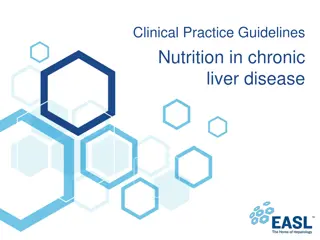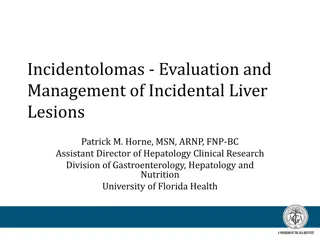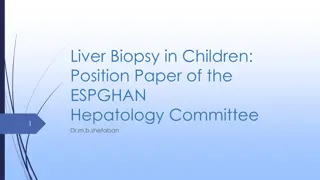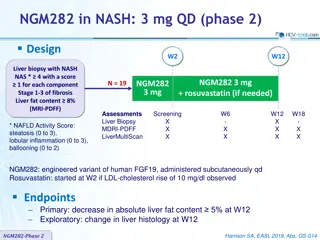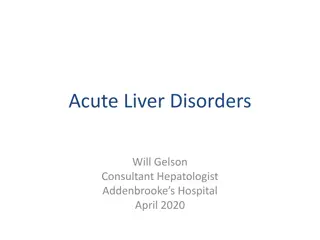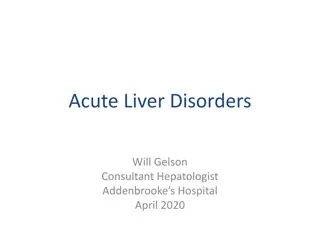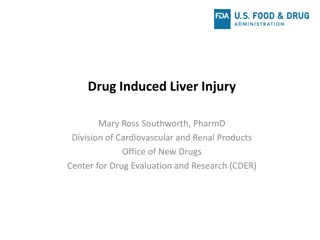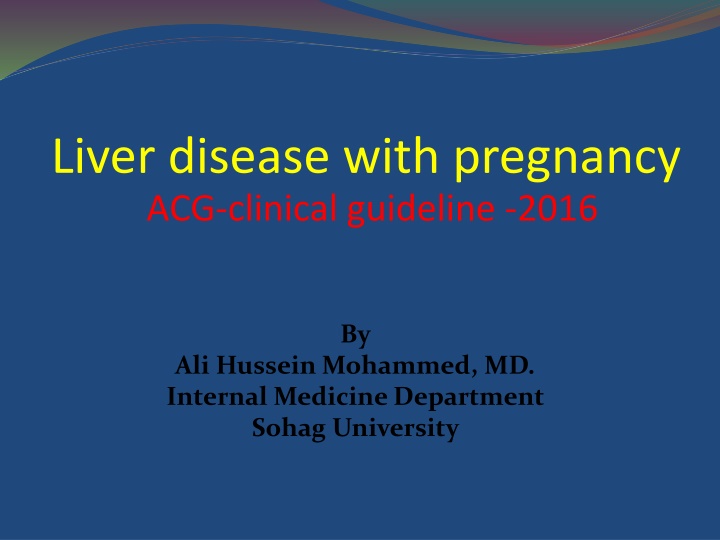
Managing Liver Disease in Pregnancy: ACG Clinical Guidelines 2016
Learn about the evaluation and management of pregnant patients with liver disease according to the ACG clinical guidelines in 2016. Understand the importance of considering both the mother and unborn fetus in treatment decisions. Explore the grading system for recommendations and the quality of evidence supporting them.
Download Presentation

Please find below an Image/Link to download the presentation.
The content on the website is provided AS IS for your information and personal use only. It may not be sold, licensed, or shared on other websites without obtaining consent from the author. If you encounter any issues during the download, it is possible that the publisher has removed the file from their server.
You are allowed to download the files provided on this website for personal or commercial use, subject to the condition that they are used lawfully. All files are the property of their respective owners.
The content on the website is provided AS IS for your information and personal use only. It may not be sold, licensed, or shared on other websites without obtaining consent from the author.
E N D
Presentation Transcript
Liver disease with pregnancy ACG-clinical guideline -2016 By Ali Hussein Mohammed, MD. Internal Medicine Department Sohag University
: AGENDA INTRODUCTION AND ( GRADE ) SYSTEM. 1. EVALUATION OF PREGNANT PATIENT WITH ABNORMAL LIVER 2. ENZYMES. IMAGING IN PREGNANY . 3. ENDOSCOPY IN PREGNANCY. 4. MANAGEMENT OF BILIARY DISEASE IN PREGNANCY 5. LIVER MASSES IN PREGNANCY. 6. HEPATITIS B IN PREGNANCY. 7. HEPATITIS C IN PREGNANCY. 8. LIVER DISEASE UNIQUE TO PREGNANCY. 9. 10. COINCIDENT LIVER DISEASE WITH PREGNANCY. 11. OTHER CHRONIC LIVER DISEASE.
INTRODUCTION AND ( GRADE ) SYSTEM. Management of pregnant women with liver disease is a common clinical scenario, and one that can be challenging given the need to consider not only the expectant mother, but also the unborn fetus in treatmentdecisions. The ACG practice guidelines have implemented the use of the Grading of Recommendation Assessment, Development, and Evaluation (GRADE) system. The strength of recommendations in the GRADE system is classified as : Strong (when the positive effects of an intervention or recommendation clearly are greater than the negative effects) or Conditional (when there is uncertainty regarding the positive vs. negativeaspectsof the recommendation).
The quality of evidence supporting strong or conditional recommendations is designated byone of four levels: High (suggesting that further research is unlikely to change the authors confidence in the estimateof effect) Moderate (further research would be anticipated to have an impacton the confidence in the estimateof effect) Low quality (further research would be anticipated to have an important impact on the confidence in the estimate of the effectand also likelychange theestimate) Very lowquality (the estimateof effect is uncertain) . --------------------------------------------------------------------------------------- Guyatt GH , Oxman AD , Vist GE et al. GRADE: an emerging consensus on rating quality of evidence and strength of recommendations . BMJ 2008 ; 336 : 924 6
EVALUATION OF THE PREGNANT PATIENT WITH ABNORMAL LIVER ENZYMES. The basis for the workup of abnormal liver tests in a pregnant woman should be predicated on understanding the normal physiological changesobserved during pregnancy. The incidence of abnormal liver tests in pregnant women is ~3 5%, even in this relativelyyoung and healthy population. The first step in assessing a woman presenting at any stage of pregnancy with abnormal liver tests should be the same as with any non-pregnant patient. A complete history, physical exam, and standard serological workup should be performed as indicated by the clinical presentation. ------------------------------------------------------------------------- Am J Gastroenterol advance online publication, 2 February 2016; doi: 10.1038/ajg.2015.430
Normal physiologic changes in lab tests during pregnancy Test Change in pregnancy AST/ALT Bilirubin Prothrombin /INR Albumin (hemodilution) Alkaline phosphatase(placenta) Hemoglobin (hemodilution) Alpha fetoprotein(placenta) 5 nucleotidase Gamma glutamyl transpeptidase
IMAGING IN PREGNANY Recommendations:
ENDOSCOPY IN PREGNANCY Endoscopy can be safe and effective if careful assessment of the risks, benefits, and clinical rationale is performed. One of the most important clinical issues in endoscopy of the pregnant patient is to ensure hemodynamic stability and oxygenation. Oversedation, positioning that compresses the inferior vena cava can lead to decreased uterine blood flow and fetal hypoxia. Thus, the patient should be positioned in the left lateral position to avoid vascular compression and aggressively managed with respect to intravenous hydration. ------------------------------------------------------------------- Gilinsky NH , Muthunayagam N . Gastrointestinal endoscopy in pregnant and lactating women: emerging standard of care to guide decisionmaking Obstet and Gynecol Survey 2006 ; 61 : 791 9 . resulting in hypotension or hypoxia, or
The benzodiazepine class of sedatives (FDA category D) should be avoided in pregnancy owing to known congenital malformations . Meperidine is an FDA pregnancy category C . Propofol is an FDA pregnancy category B anesthetic which is very short acting with a rapid recovery period, which is of significant benefit in thecase of a pregnant patient. ----------------------------------------------------------------------------- Cappell MS . Risks versus benefi ts of gastrointestinal endoscopy during pregnancy . Nat Rev Gastroenterol Hepatol 2011 ; 8 : 610 34 .
Recommendations: 5. Endoscopy is safe in pregnancy but should be deferred until the second trimester if possible . (strong recommendation,low level of evidence). 6. Meperidine and propofol can be used for endoscopic sedation. (strong recommendation, moderate level of evidence).
MANAGEMENT OF BILIARY DISEASE IN PREGNANCY Cholelithiasis is common in pregnancy due to the increased estrogen levels. Cholecystitis is the second most common surgical condition in pregnancy. The incidence of cholelithiasis in pregnant women is 3.5% Biliary pancreatitis, symptomatic choledocholithiasis, and cholangitis ; have poor intervention. ERCP safety has been reported in multiple series, with some reports of increased pancreatitis risk (16%). Reducing fetal exposure to radiation should be done by limiting fluoroscopy time, external fetal shielding, and adjusting the patient position. ---------------------------------------------------------------------- fetal outcomes without Tang SJ , Mayo MJ , Rodriguez-Frias E etal. Safetyand utility of ERCP during pregnancy . Gastrointest Endosc 2009 ; 69 : 453 61.
Recommendations: 7. ERCP can be performed when indicated for pregnant women presenting with biliary disease that strongly necessitates intervention such as biliary pancreatitis, symptomatic choledocholithiasis, and/or cholangitis. Minimizing fetal exposure to fluoroscopy is imperative (strong recommendation, low level of evidence). 8. Symptomatic cholecystitis should be managed with early surgical intervention with laparoscopic cholecystectomy (strong recommendation, low level of evidence).
LIVER MASSES IN PREGNANCY liver masses discovered during pregnancy are rare and mostcommonlyare benign. Hemangiomas, focal nodular hyperplasia, and hepatic adenoma may be discovered on routine imaging with ultrasound. Hepatic adenomas have a higher risk of growth during pregnancy due to hormonal stimulation, Ultrasound monitoring pregnancy . should be done during
Primary livercancer in pregnancy isvery rare . Very poor prognosis (maternal & fetal) ,aggressive course (HCG, estrogen the growth of cancer cells , risk of tr rupture ) Surgery : resection is the bestcurative ttt. 1sttrimester: maternal survival takes precedence (termination + resection) 2nd: resection without termination . 3rd: C section + resection (simultaneously ). Sorafenib: FDA; D. ------------------------------------------------------------------------- Int J Surg Case Rep.2014;5(11):882-885Published online 2014 Sep 10.
Recommendations: 9. Asymptomatic hemangioma and focal nodular hyperplasia do not need surveillanceduring pregnancy. (strong recommendation, very low level evidence). routine imaging or 10. Hepatic adenomas should be monitored with ultrasound during pregnancy forgrowth. Patients with large adenomas (>5 cm) should be referred forresection beforepregnancy. (strong recommendation, low level of evidence).
HEPATITIS B IN PREGNANCY Recommendations: 11-Active passive immunoglobulin and the HBV vaccination series should be administered to all infants born to HBV-infected mothers to prevent perinatal transmission (strong recommendation, low level of evidence). immunoprophylaxis with hepatitis B 12-Women chronically infected with HBV and high viral load (>10 log copies/ml (200,000 IU/ml) and higher) should be offered antiviral medication with tenofovir or telbivudine in the third trimester to reduce perinatal transmission of HBV (strong recommendation, low level of evidence).
13-C-section should not be performed electively in HBV-positive mothers to prevent fetal infection (strong recommendation, very low level of evidence). 14-Women chronically infected with HBV should be allowed to breastfeed as recommended for infant health. (strong recommendation, very low level of evidence).
HEPATITIS C IN PREGNANCY Recommendation: 15-All pregnant women with risk factors for HCV should be screened with anti-HCV antibody. Screening should not be performed in women without risk factor for HCV acquisition (strong recommendation, low level of evidence). 16-Invasive procedures (e.g., amniocentesis, invasive fetal monitoring) should be minimized in infected mothers and their fetus to prevent vertical transmission of hepatitis C (strong recommendation, very low level of evidence).
17-C-section should not be performed electively in HCV- positive mothers to prevent recommendation, very low level of evidence). fetal infection (strong 18-Women chronically infected with HCV should be allowed to breastfeed as indicated for recommendation, very low level of evidence). infant health (strong 19-Hepatitis C therapy should not be offered to pregnant women to either treat HCV or decrease the risk for vertical transmission (strong recommendation, very low level of evidence).
LIVER DISEASE UNIQUE TO PREGNANCY Disorder Trimester Management HG First 20 weeks Supportive management IHCP Second/third Ursodeoxycholic acid 10 15 mg/kg Early delivery at 37 weeks AFLP Third Women with AFLP should be delivered promptly Infant should be monitored for manifestations of of long- chain 3-hydroxyacyl-coenzyme A dehydrogenase including hypoglycemia and fatty liver. After 20 weeks After 36 weeks, women with severe preeclampsia should be delivered promptly. Eclampsia Pre HELLP After 22weeks Delivery after 34 weeks. Platelet transfusion ( 40,000 50,000 cells/ l ) should be considered before delivery, especially if CS is likely.
Swansea criteria for diagnosis of acute fatty liver of pregnancy Six or more criteria required in the absence of another cause 1. Vomiting 2. Abdominal pain 3. Polydipsia/polyuria 4. Encephalopathy 5. Elevated bilirubin 6. Hypoglycaemia 7. Elevated urea 8. Leucocytosis 9. Ascites or bright liver on ultrasound scan 10. Elevated transaminases (AST or ALT) 11. Elevated ammonia 12. Renal impairment; 13. Coagulopathy; 14. Microvesicularsteatosison liver biopsy ------------------------------------------------------------------------------------------------------- >14 mol/l <4 mmol/l >340 mol/l >11 10 6 cells/l >42 IU/l >47 mol/l creatinine >150 mol/l prothrombin time >14 s or APPT>34 s
Recommendations: The treatment of hyperemesis gravidarum (HG) is supportive and may require hospitalization (strong recommendation, very low level of evidence). 12. Because of increased risk of fetal complications with intrahepatic cholestasis of pregnancy (IHCP), early delivery at 37 weeks is recommended. (strong recommendation, very low level of evidence). 13. Ursodeoxycholic acid (UDCA) should be given at 10 15 mg/kg to women with IHCP for symptomatic improvement. (strong recommendation, moderate level of evidence).
Preeclampsia with hepatic involvement elevates the diagnosis to severe preeclampsia. After 36 weeks, women with severe preeclampsia should be delivered promptly to limit maternal and fetal complications. (strong recommendation, very low level of evidence). 15. (HELLP) syndrome should be managed by prompt delivery, especially after 34 weeks gestation. (strong recommendation, very low level of evidence). 16. Platelet transfusion ( 40,000 50,000 cells/ l ) should be considered before delivery, especially if C-Section is likely. (conditional recommendation, very low level of evidence).
. Women with acute fatty liver disease of pregnancy (AFLP) should be delivered management is not appropriate. (strong recommendation, very low level of evidence). promptly; expectant 18. All women with AFLP and their children should have molecular testing for long-chain 3-hydroxyacyl-CoA dehydrogenase (LCHAD); (conditional recommendation, moderate level of evidence).
COINCIDENT LIVER DISEASE WITH PREGNANCY(HAV,HEV,HSV) Recommendations: 19. Pregnant women presenting with acute hepatitis should be tested for common etiologies of acute liver injury including viral hepatitis, hepatitis A virus (HAV), hepatitis B virus (HBV), hepatitis E virus (HEV), and herpes simplex virus (HSV); ( strong recommendation, very low level of evidence). 20. Pregnant women with acute hepatitis suspected from HSV should be initiated on Acyclovir. (FDA, B). (strong recommendation, very low level of evidence).
Budd Chiari syndrome : This syndrome results from an obstruction of the hepatic vein or the suprahepatic portion of vena cava ,mostly by thrombosis.( pregnancy). Diagnosis is made by Doppler imaging after C/P. Treatment : Anticoagulation (heparin) TIPS liver transplantation.
OTHER CHRONIC LIVER DISEASE (Recommendations); 21-Pregnant women with autoimmune hepatitis (AIH) should be continued on their treatment with corticosteroids and/or azathioprine (AZA). (strong recommendation, very low level of evidence) 22. Pregnant women with primary biliary cirrhosis (PBC) should be continued on their treatment with UDCA. (strong recommendation very low level of evidence). 23- Pregnant women with Wilson s disease (WD) should be continued, with dose reduction if possible, on their treatment with penicillamine, trientineor zinc . (strong recommendation, very low level of evidence).
24. Pregnant women with suspected portal hypertension should undergo screening with upper endoscopy for esophageal varices in the second trimester . (strong recommendation, low level of evidence). 25. Pregnant women who are found to have large esophageal varices should be treated with beta-blockers and/or band ligation . (conditional recommendation, very low level of evidence). 26. Pregnant women with a history of liver transplantation should continue their immunosuppression except for mycophenolicacid . (strong recommendation, moderate level of evidence) .

